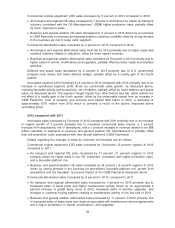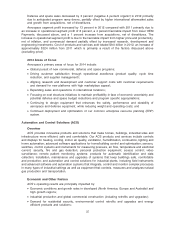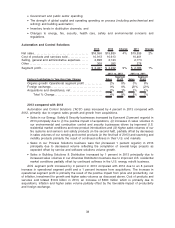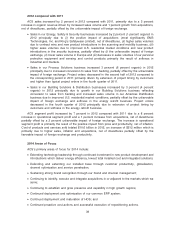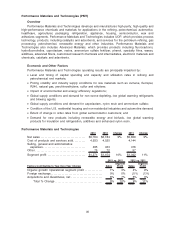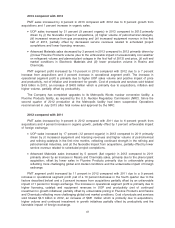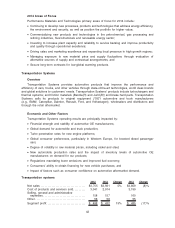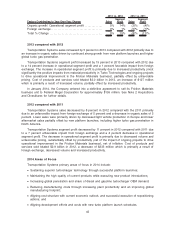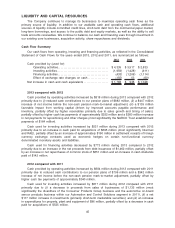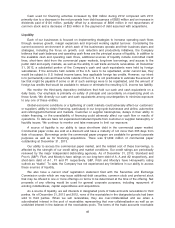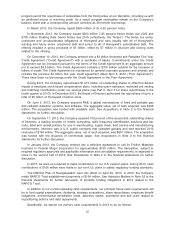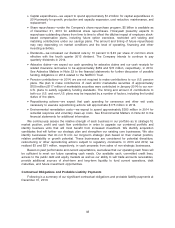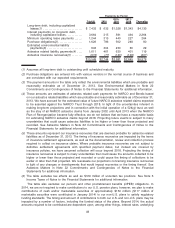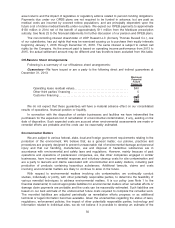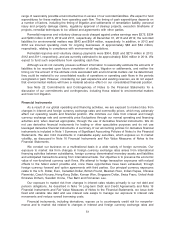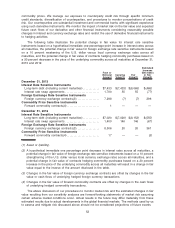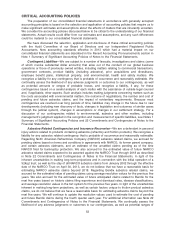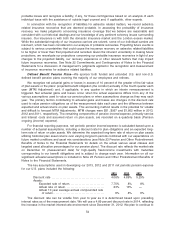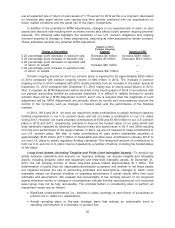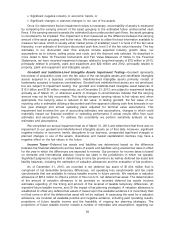Honeywell 2013 Annual Report Download - page 58
Download and view the complete annual report
Please find page 58 of the 2013 Honeywell annual report below. You can navigate through the pages in the report by either clicking on the pages listed below, or by using the keyword search tool below to find specific information within the annual report.Cash used for financing activities increased by $92 million during 2012 compared with 2011
primarily due to a decrease in the net proceeds from debt issuances of $825 million and an increase in
dividends paid of $120 million, partially offset by a decrease of $806 million in net repurchases of
common stock and a decrease of $33 million in the payment of debt assumed with acquisitions.
Liquidity
Each of our businesses is focused on implementing strategies to increase operating cash flows
through revenue growth, margin expansion and improved working capital turnover. Considering the
current economic environment in which each of the businesses operate and their business plans and
strategies, including the focus on growth, cost reduction and productivity initiatives, the Company
believes that cash balances and operating cash flows are the principal source of liquidity. In addition to
the available cash and operating cash flows, additional sources of liquidity include committed credit
lines, short-term debt from the commercial paper markets, long-term borrowings, and access to the
public debt and equity markets, as well as the ability to sell trade accounts receivables. At December
31, 2013, a substantial portion of the Company’s cash and cash equivalents were held by foreign
subsidiaries. If the amounts held outside of the U.S. were to be repatriated, under current law, they
would be subject to U.S. federal income taxes, less applicable foreign tax credits. However, our intent
is to permanently reinvest these funds outside of the U.S. It is not practicable to estimate the amount of
tax that might be payable if some or all of such earnings were to be repatriated, and the amount of
foreign tax credits that would be available to reduce or eliminate the resulting U.S. income tax liability.
We monitor the third-party depository institutions that hold our cash and cash equivalents on a
daily basis. Our emphasis is primarily on safety of principal and secondarily on maximizing yield on
those funds. We diversify our cash and cash equivalents among counterparties to minimize exposure
to any one of these entities.
Global economic conditions or a tightening of credit markets could adversely affect our customers’
or suppliers’ ability to obtain financing, particularly in our long-cycle businesses and airline, automotive
and refining/petrochemical end markets. Customer or supplier bankruptcies, delays in their ability to
obtain financing, or the unavailability of financing could adversely affect our cash flow or results of
operations. To date we have not experienced material impacts from customer or supplier bankruptcy or
liquidity issues. We continue to monitor and take measures to limit our exposure.
A source of liquidity is our ability to issue short-term debt in the commercial paper market.
Commercial paper notes are sold at a discount and have a maturity of not more than 365 days from
date of issuance. Borrowings under the commercial paper program are available for general corporate
purposes as well as for financing acquisitions. There was $1,299 million of commercial paper
outstanding at December 31, 2013.
Our ability to access the commercial paper market, and the related cost of these borrowings, is
affected by the strength of our credit rating and market conditions. Our credit ratings are periodically
reviewed by the major independent debt-rating agencies. As of December 31, 2013, Standard and
Poor’s (S&P), Fitch, and Moody’s have ratings on our long-term debt of A, A and A2 respectively, and
short-term debt of A-1, F1 and P1 respectively. S&P, Fitch and Moody’s have Honeywell’s rating
outlook as “stable”. To date, the Company has not experienced any limitations in our ability to access
these sources of liquidity.
We also have a current shelf registration statement filed with the Securities and Exchange
Commission under which we may issue additional debt securities, common stock and preferred stock
that may be offered in one or more offerings on terms to be determined at the time of the offering. Net
proceeds of any offering would be used for general corporate purposes, including repayment of
existing indebtedness, capital expenditures and acquisitions.
As a source of liquidity, we sell interests in designated pools of trade accounts receivables to third
parties. As of December 31, 2013 and 2012, none of the receivables in the designated pools had been
sold to third parties. When we sell receivables, they are over-collateralized and we retain a
subordinated interest in the pool of receivables representing that over-collateralization as well as an
undivided interest in the balance of the receivables pools. The terms of the trade accounts receivable
46


